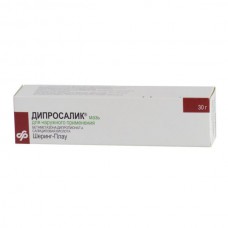Expiration date: 03/2026
International name:
Betamethasone+Salicylic acid (Betamethasone+Salicylic acid)
Group affiliation:
The glucocorticosteroid+keratolytic tool
Description of the active substance (INN):
Betamethasone+Salicylic acid
Dosage form:
ointment for external use, topical solution
Pharmacological action:
Combined preparation, which is included in the composition components, anti-inflammatory, antiedemic, antiallergic, a vasoconstrictor, antiproliferative, antiviral, keratolytic, antimicrobial, antifungal and local hypothermic effect. Inhibits the release of mediators of inflammation, warns boundary accumulation of neutrophils, reduces inflammatory exudation and production of cytokines, reduces the migration of macrophages, resulting in the reduction processes of infiltration and granulation. Due to the presence of salicylic acid softens the skin and removes Horny layers and promotes deeper penetration of the corticosteroids. The ointment has a water-repellent effect and forms a protective film that protects the skin from external moisture, possessing deep Ironsides effect, the most suitable for the treatment of patients with dry and fragile skin. Lotion (solution of fat-free basis) are easily distributed on the skin surface, not pieces and dry hair, leaves no visible traces, has a cooling effect on the skin.
Indications:
Psoriasis, eczema (especially chronic), ichthyosis, pruritus limited with strong lehenetsia, atopic dermatitis, diffuse neurodermatitis, simple and allergic dermatitis, urticaria, erythema multiforme exudative simple chronic zoster (limited neurodermatitis). Dermatoses, not treatable. GCS (especially red warty lichen), lichen planus, dishidros skin.
Contraindications:
Hypersensitivity, bacterial, viral and fungal skin diseases (pyoderma, syphilis, tuberculosis skin, chicken pox, herpes, actinomycosis, blastomycosis, sporotrichosis), postvaccinal skin reactions, perioral dermatitis, rosacea, trophic ulcers on the background of chronic venous insufficiency, and skin tumors (skin cancer, nevus, sebaceous cyst, epithelioma, melanoma, hemangioma, xanthoma, Kaposi), pregnancy, lactation (not to apply to the skin of the breast before feeding), children up to age 1 year.C caution. Liver failure, children's age (over 1 year), long-term therapy, especially the use of occlusive dressings.
Side effects:
Burning, irritation, dryness, hypopigmentation, skin itching, folliculitis, hypertrichosis, acneiform rash. With the use of occlusive dressings - maceration of the skin, striae, skin atrophy, secondary infection, miliaria. Long-term use - skin atrophy, local hirsutism, telangiectasia, purpura, hypopigmentation, hypertrichosis. When applied to large surfaces - the system of side effects of corticosteroids (growth retardation, the syndrome Itsenko-Kushinga, benign intracranial hypertension after treatment, hyperglycemia, glucosuria, hypokalemia, increased blood pressure) or salicylates (pallor, fatigue, drowsiness, hyperventilation on the background of tachypnea, nausea, vomiting, hearing loss, confusion).
Overdose:
Symptoms: secondary adrenal insufficiency, hypercortisolism, Cushing's syndrome. Treatment: symptomatic.
Method of application and dose:
Externally, to the affected areas, gently rubbing, apply a thin layer 2-3 times a day. If necessary, apply an occlusive bandage, which is changed every 24 hours (due to the delay evaporation of sweat and skin breathing creates a moist chamber, contributing to the loosening of the stratum corneum and increased, deeper penetration of the drug is approximately 100 times greater than for a simple application). The course of treatment - up to 3 weeks. If necessary, long-term treatment applied less frequently through the day. In the treatment of chronic diseases the treatment must continue for some time after the disappearance of symptoms to avoid relapse.
Special instructions:
Avoid falling drug in the eye, can cause the skin near the eyes and mucous membranes. Avoid prolonged application on the skin may develop dermatitis-type of rosacea, perioral dermatitis, skin atrophy and acne, to avoid the use of the anogenital region. The use of sunscreen for children should be as brief as possible (risk of systemic absorption of proportionally larger number of active components due to the prevalence area of the skin over the body mass and lack of maturity of the epidermis). If signs of allergic reactions or local irritation, treatment should be discontinued.


